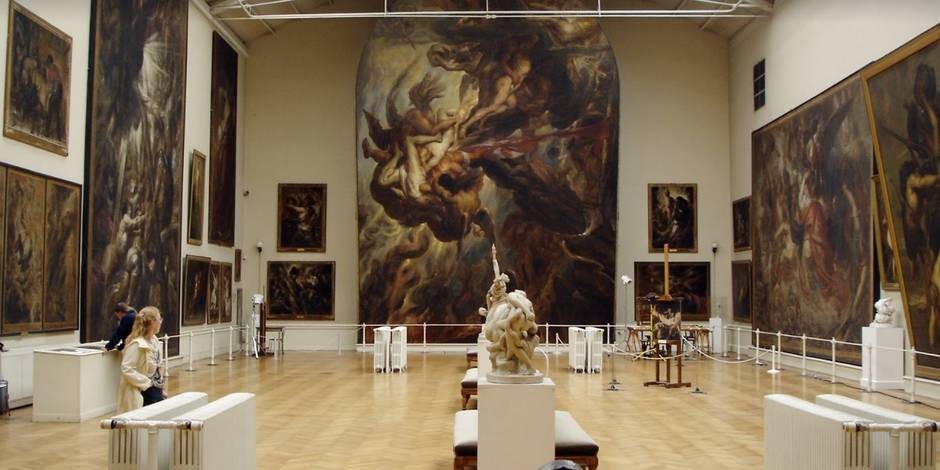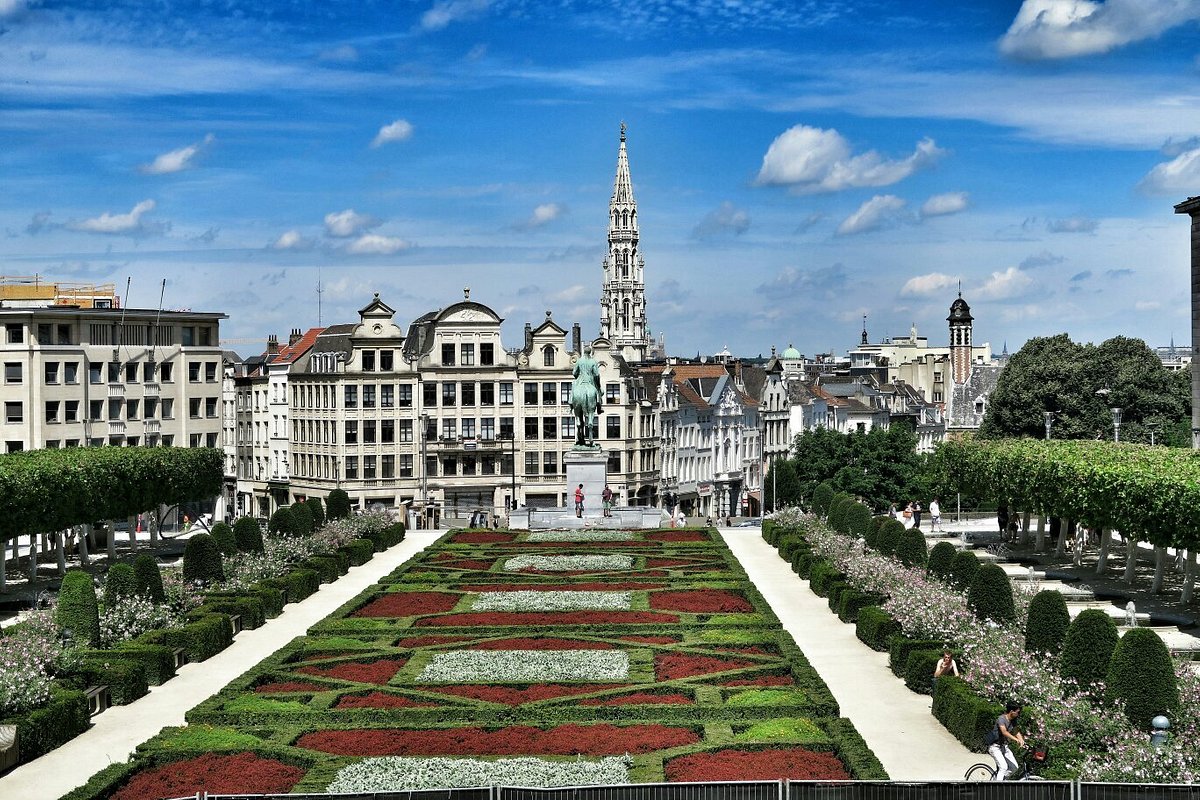Brussels is the most densely populated region in Belgium, and although it has the highest GDP per capita, it has the lowest available income per household. The Brussels Region covers 162 km2 (63 sq mi), a relatively small area compared to the two other regions, and has a population of over 1.2 million. The five times larger metropolitan area of Brussels comprises over 2.5 million people, which makes it the largest in Belgium.It is also part of a large conurbation extending towards the cities of Ghent, Antwerp, and Leuven and the province of Walloon Brabant, in total home to over 5 million people.
Brussels grew from a small rural settlement on the river Senne to become an important city-region in Europe. Since the end of the Second World War, it has been a major centre for international politics and home to numerous international organisations, politicians, diplomats and civil servants. Brussels is the de facto capital of the European Union, as it hosts a number of principal EU institutions, including its administrative-legislative, executive-political, and legislative branches (though the judicial branch is located in Luxembourg, and the European Parliament meets for a minority of the year in Strasbourg). Because of this, its name is sometimes used metonymically to describe the EU and its institutions. The secretariat of the Benelux and the headquarters of NATO are also located in Brussels.
As the economic capital of Belgium and a top financial centre of Western Europe with Euronext Brussels, Brussels is classified as an Alpha global city. It is also a national and international hub for rail, road and air traffic, and are sometimes considered, together with Belgium, as the geographic, economic and cultural crossroads of Europe. The Brussels Metro is the only rapid transit system in Belgium. In addition, both its airport and railway stations are the largest and busiest in the country.
1.Saint-Michel Cathedral

The Cathedral of St. Michael and St. Gudula, usually shortened to the Cathedral of St. Gudula or St. Gudula by locals, is a medieval Roman Catholic cathedral in central Brussels, Belgium.
The Cathedral of St. Michael and St. Gudula usually shortened to the Cathedral of St. Gudula or St. Gudula by locals, is a medieval Roman Catholic cathedral in central Brussels, Belgium. It is dedicated to Saint Michael and Saint Gudula, the patron saints of the City of Brussels, and is considered to be one of the finest examples of Brabantine Gothic architecture.
The Romanesque church’s construction began in the 11th century, replacing an earlier chapel, and was largely complete in its current Gothic form by the 16th, though its interior was frequently modified in the following centuries. The building includes late-Gothic and Baroque chapels, whilst its neo-Gothic decorative elements, including some of its stained glass windows in the aisles, date from restoration work in the 19th century. St. Gudula also stands out for its musical components, notably its two pipe organs and its immense church bells. The complex was designated a historic monument in 1936.
2.Visit Mannekin Pis

Manneken Pis has been repeatedly stolen or damaged throughout its history. Since 1965, a replica has been displayed with the original stored in the Brussels City Museum. It is one of the best-known symbols of Brussels and Belgium, inspiring many imitations and similar statues. The figure is regularly dressed up and its wardrobe consists of around one thousand different costumes. Due to its self-derisive nature, it is also an example of belgitude (French; lit. ’Belgianness’), as well as of folk humour (zwanze) popular in Brussels.
Manneken Pis is a landmark 55.5 cm bronze fountain sculpture in central Brussels, Belgium, depicting a puer mingens; a naked little boy urinating into the fountain’s basin.
Along the Rue de l’Etuve is Brussels’ best-known landmark, the Manneken Pis, usually besieged by a throng of tourists.
Although he can be traced back to at least 1388, nothing much is known about the origin of the figure of a little boy urinating, popularly referred to as “the oldest citizen of Brussels.”
The Manneken is, however, surrounded by various legends. According to one, the fountain is a memorial to a courageous infant who averted a conflagration, according to another, it commemorates the son of a count who succumbed to a pressing urge while taking part in a procession.
3.Tour the Place Royale (Koningsplein)
The Place Royale is a historic neoclassical square in the Royal Quarter of Brussels, Belgium. Modelled after the so-called French royal square and built between 1775 and 1782, according to a plan of the architects Jean-Benoît-Vincent Barré and Gilles-Barnabé Guimard, to replace the former Palace of Coudenberg, it was part of an urban project including Brussels Park.
The Place Royale is one of oldest architecturally consistent and monumental public squares, as well as an excellent example of 18th-century urban architecture. Rectangular and symmetrical in shape, it measures 77 by 113 metres (253 by 371 ft)and is entirely paved. In its centre stands an equestrian statue of Godfrey of Bouillon. It is also flanked by the Church of St. James on Coudenberg, as well as some of the main museums in the city.
A favorite attraction for photo-ops, the most important building on this square is the Royal Palace (Palais Royal), which is used by the Belgian royal family as an official residence.
The Belgian flag, flown from the roof, signals the sovereign’s presence, and a ceremonial Changing of the Guard takes place every day at about 2:30pm.
From late July to late August, free guided tours of the palace’s interior, taking in the grand reception rooms and halls, are available.
Surrounding the palace are an ensemble of cultural buildings boasting Neoclassical facade.
4.Enter the Atomium

The Atomium is a landmarkmodernist building in Brussels, Belgium, originally constructed as the centrepiece of the 1958 Brussels World’s Fair (Expo 58). Designed by the engineer André Waterkeyn and the architects André and Jean Polak as a tribute to scientific progress, as well as to symbolise Belgian engineering skills at the timeit is located on the Heysel/Heizel Plateau in Laeken (northern part of the City of Brussels), where the exhibition took place. It is the city’s most popular tourist attraction, and serves as a museum, an art centre and a cultural destination.
The Atomium stands 102 metres (335 ft) tall, making it one of the tallest structures in Belgium. Its nine 18-metre-diameter (59 ft) stainless steel clad spheres are connected in the shape of a unit cell that could represent an iron crystal magnified 165 billion times. Steel tubes connecting the spheres enclose stairs, escalators and an elevator (in the central, vertical tube) to allow access to the six visitable spheres, which contain exhibit halls and other public spaces. The top sphere includes a restaurant with a panoramic view of Brussels. The building was completely renovated between 2004 and 2006 by the companies Jacques Delens and BESIX
The Atomium is a landmark modernist building in Brussels, Belgium, originally constructed as the centrepiece of the 1958 Brussels World’s Fair.
Along with Manneken Pis, the Atomium is Brussels’ best-known landmark attraction, and although it’s a bit of a journey by tram to get out here, the bizarre 102-meter-high steel and aluminum structure, designed by the architect André Waterkeyn for the 1958 Brussels World Exhibition, is the city’s most surreal sight.
The building represents a molecule of iron magnified 165 million times.
Today, visitors can enter the building to explore its sci-fi-style interiors. The lower spheres are home to a permanent exhibition on the history of the structure. The upper sphere has incredible panoramas across the city.
5. Coudenberg Palace Archaeological Site
The Palace of Coudenberg was a royal residence situated on the Coudenberg or Koudenberg, a small hill in what is today the Royal Quarter of Brussels, Belgium.
One of Brussels’ most unique things to do is explore this active archaeological site, which was rediscovered in the 1980s.
Coudenberg Palace has been excavated to reveal the cellars and tunnels of the former Palace of Brussels, as well as forgotten streets that had been buried beneath the city for centuries.
The foundations of the medieval palace have been cleared to allow tourists the opportunity to explore, and the museum has free audio guides that take you through the dig site.
For nearly 700 years, the Castle and then Palace of Coudenberg was the residence (and seat of power) of the counts, dukes, archdukes, kings, emperors or governors who, from the 12th century to the 18th century, exerted their sovereignty over the Duchy of Brabant and later over all or part of the Burgundian and then Spanish and Austrian Netherlands.
The palace was completely destroyed in an accidental fire which broke out on the night of 3 February 1731. Only the underground parts remain today. After several years of recent excavations, the archaeological vestiges of the palace and its foundations are open to the public.
6. Mont des Arts
The Mont des Arts or Kunstberg, meaning “Hill/Mount of the Arts”, is an urban complex and historic site in central Brussels, Belgium, including the Royal Library of Belgium, the National Archives of Belgium, the Square – Brussels Meeting Centre, and a public garden.
The Mont des Arts meaning “Hill/Mount of the Arts”, is an urban complex and historic site in central Brussels, Belgium, including the Royal Library of Belgium (KBR), the National Archives of Belgium, the Square – Brussels Meeting Centre, and a public garden.
This site is located between the Rue Montagne de la Cour/Hofbergstraat and the Place Royale/Koningsplein in its “upper” part, and the Boulevard de l’Empereur/Keizerslaan and the Place de l’Albertine/Albertinaplein in its “lower” part. It is served by Brussels Central Station.
The Mont des Arts was created between 1956 and 1958, occupying the elevated site between the Place Royale and the Place de l’Albertine.
The architecturally imposing complex of large buildings includes the Bibliothèque Albert I and the strikingly modern Palais de la Dynastie and Palais Congrès.
From the square between them is a fine view of the lower central city. The Bibliothèque Albert I was founded during the period of Burgundian rule and comprises more than three million volumes together with a valuable collection of manuscripts and several interesting museums.
7.Meunier Museum

Constantin Meunier (1831-1905) had this beautiful house-cum-studio built towards the end of his life. Sheltering an extensive collection of over 700 works, the house was acquired by the Belgian state in 1936 and opened to the public in 1939. Attached to the Royal Museums of Fine Arts of Belgium, and subsequently renovated, it has since 1986 presented a selection of about 150 works and documents.
The house and studio of Constantin Meunier (1831-1905) is now home to a museum dedicated to his work.
Meunier was a Belgian artist who, in his later paintings and sculptural works, concentrated on a social realist style that was hugely influential on artists throughout the early years of the 20th century. His sculptures of industrial workers are particularly well known.
The museum displays a selection of approximately 150 paintings, drawings, sculptures, and plaster models from its collection of 700, providing an excellent grounding and introduction to Meunier’s work.
The building itself, which Meunier had built towards the end of his life, is a good example of Brussels’ vernacular terraced housing.










